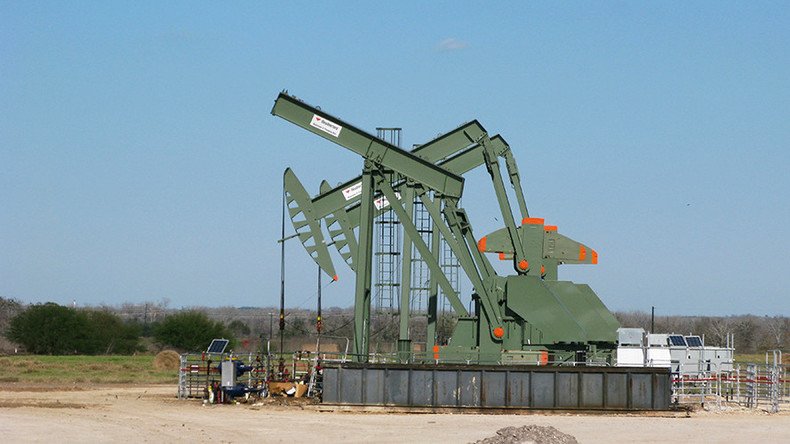EPA fracking report drops claim of no evidence of ‘widespread, systemic impact’ on drinking water

Both the fracking industry and environmentalists are spinning the Environmental Protection Agency’s findings in a finalized report on hydraulic fracturing and drinking water. The EPA ditched a key sentence from their previous draft on the subject.
Appropriating $29 million for the effort, Congress ordered the EPA to study the effects of fracking on drinking wells in 2010, and after five years of research, the agency released nearly 1,300 pages marked with inconclusive data on Tuesday.
In June 2015, the EPA produced a draft of the fracking report, stating they “did not find evidence that these mechanisms have led to widespread, systemic impacts on drinking water resources in the United States.” That one sentence was hailed by the oil and gas industry, while anti-fracking activists called it a political move by the Obama administration.
#Oklahoma residents sue energy companies over #fracking quakes https://t.co/pQC0V6nXCQpic.twitter.com/dMlmMHwOhe
— RT America (@RT_America) December 7, 2016
The finalized report released Tuesday does not include that controversial statement. Instead, the EPA stresses “data gaps and uncertainties” inhibit it from making a definitive conclusion one way or the other.
“The available data and information allowed us to qualitatively describe factors that affect the frequency or severity of impacts at the local level,” the completed EPA report reads. “However, significant data gaps and uncertainties in the available data prevented us from calculating or estimating the national frequency of impacts on drinking water resources from activities in the hydraulic fracturing water cycle. The data gaps and uncertainties described in this report also precluded a full characterization of the severity of impacts.”
This updated language triggered responses from each side of the fracking debate. Also known as hydraulic fracturing, the natural gas extraction practice consists of injecting water and a mix of chemicals at a high pressure underground to break up rocks, releasing and capturing the fuel resource.
“It’s a huge victory that the EPA has stuck to the science with this final report and not gone out on a limb and made pronouncements based more on political considerations than the science,” said Hugh MacMillan, a senior researcher for the consumer rights advocate Food & Water Watch, the Christian Science Monitor reported. MacMillan also said the report would influence local government decisions on the matter.
The Independent Petroleum Association of America’s outreach group Energy In Depth said the EPA report “blows apart the anti-fracking campaign’s most common claim, namely that hydraulic fracturing is polluting groundwater all across America,” according to The Hill.
New ‘body of evidence’ unveils #fracking threats to public health & safety https://t.co/9UO0kvkGnrpic.twitter.com/fJTwzlMMU1
— RT America (@RT_America) November 29, 2016
Katie Brown, an Energy In Depth spokeswoman, said the “EPA did its best to inject politics into this good news by inflating concerns about groundwater, no doubt as a parting thank-you gift to the ‘Keep It In the Ground’ movement,” The Hill reported.
Without confirming whether fracking directly contributed to contamination of several sites, the EPA’s report did note that incomplete investigations into operations in Dimock, Pennsylvania; Parker County, Texas; and Pavillion, Wyoming, found some pollution.
“There are instances where fracking has impacted drinking water resources,” the Deputy Assistant Administrator of the EPA's Office of Research and Development, Dr. Thomas Burke, told reporters Tuesday, the Associated Press reported. But Dr. Burke said that with regard to a “national, systemic conclusion,” “that’s a different question [that] this study does not have adequate evidence to make a conclusive, quantified statement about.”
#ScottPruitt and his many fights against #EPA, the agency he's picked to lead https://t.co/Teh9NH51ovpic.twitter.com/P4pOsCdR0c
— RT America (@RT_America) December 9, 2016
While the incoming Trump administration’s position on fracking is unlikely to be persuaded by the report, local and state governments may consider the report’s advice on decreasing the risk of drinking water contamination from fracking. The EPA lists six “combinations of activities and factors” to avoid, including “water withdrawals for hydraulic fracturing in times or areas of low water availability,” spills of chemical-laden fracking fluids reaching groundwater, the hydraulic fracturing of “wells with inadequate mechanical integrity,” and reckless disposal or storage of fracking fluids.












